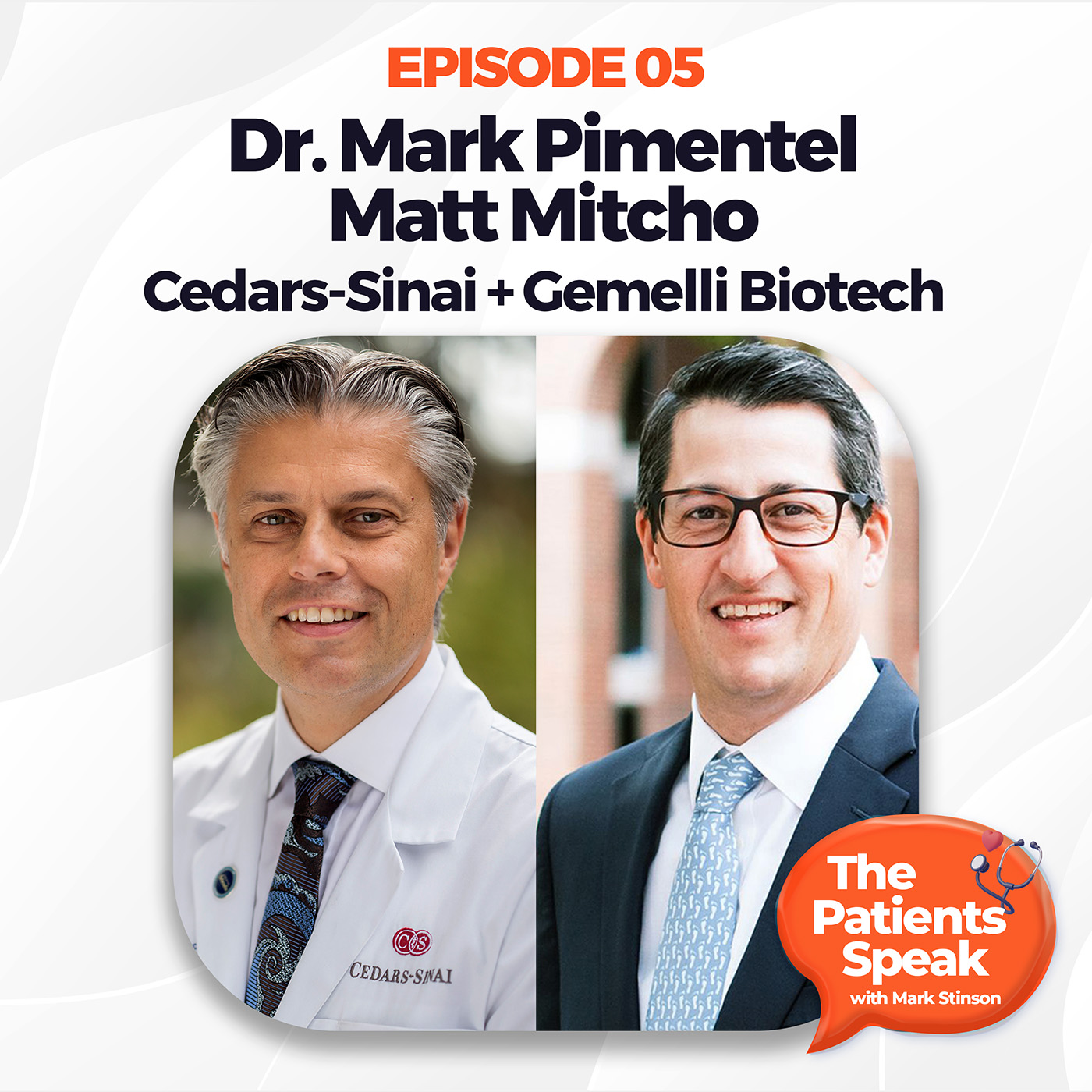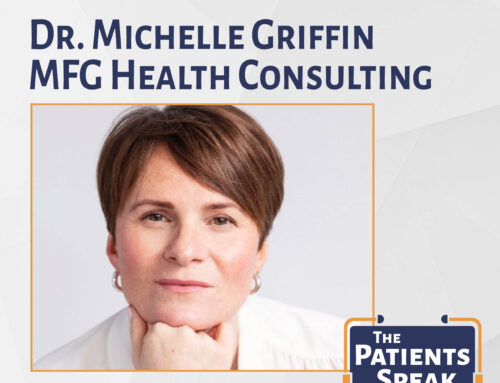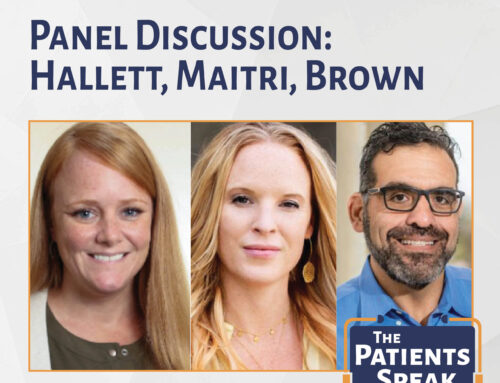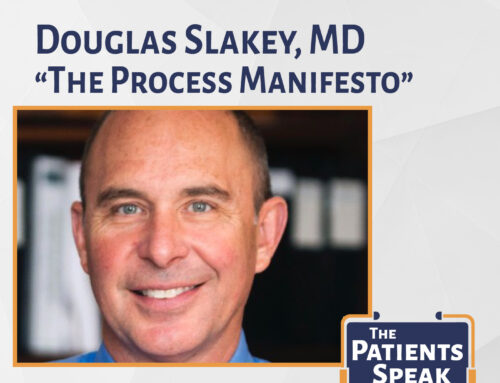Welcome back to one of the first episodes of our new podcast, The Patients Speak. We’re combining the business aspects of innovation and the science of innovation with the patient voice and what the opportunities are to incorporate more of the patient experience into our strategies and into our work.
Today, we’re joined by Dr. Mark Pimentel, executive director of the MAST( Medically Associated Science and Technology) program at Cedar Sinai. And, by Matt Mitcho, CEO of Gemelli Biotech. Dr. Pimentel is also a co-founder and a member of the scientific advisory board at Gemelli.
Mark Stinson:
Well, hello again friends and welcome back to one of the first episodes of our new podcast, The Patients Speak. We’re combining the business aspects of innovation and the science of innovation with the patient voice and what the opportunities are to incorporate more of the patient experience into our strategies and into our work.
Today, we’re so happy to talk to two experts in bringing that research from the bench to the market. We’re joined by Dr. Mark Pimentel. He’s executive director of the MAST program at Cedar Sinai. And MAST is Medically Associated Science and Technology, and by Matt Mitcho. He’s the CEO of Gemelli Biotech. And Mark is also a co-founder and a member of the scientific advisory at Gemelli. Gentlemen, welcome to the show.
Dr. Mark Pimentel:
It’s good to be here.
Matt Mitcho:
Thanks for having us.
Mark Stinson:
You bet. And I guess as we think about this idea of bringing the research from the bench, Dr. Pimentel, this is your sweet spot, bringing and outright licensing to companies, but to really bring this clinical research developments. To think about the patient, I was wondering, in addition to the clinical and the research and sort of the technology assessment, how do you tend to incorporate the patient voice into that assessment?
Dr. Mark Pimentel:
Yeah, so you’re speaking basically music to my ears because the patient voice is what drove everything or drives everything that I do. One of the things I say, and maybe this has become cliche for me is, diarrhea is not a treatment for constipation. And constipation is not a treatment for diarrhea. In other words, the industry, if you have a diarrhea patient, they want to make it stop, but they always overshoot because it’ll hit their targets for the FDA easier. And the other way, flip it around and it’s the same thing. I’m in clinic, I see the patients. I’m giving them a drug. They get diarrhea. Yeah, the constipation’s gone.
So when I see these patients and I see that there are tremendous unmet needs despite the meeting of needs with things that don’t quite fit, I think that’s what resonates with me and with the patients is that, I need to find things for patients that are going to work to get them normal, not to make them go in the opposite direction, if you know what I mean. And I think that’s what we’ve tried to do over the last 29 years or 26 years here at Cedar Sinai and the research I’ve done and hopefully made some impact.
Mark Stinson:
And thinking about that clinic side, it’s good that you’re still on the front lines as we like to say, talking eye to eye with the patients. But how do we, in a system like Cedar Sinai, how do we aggregate, collate, translate all this patient experience so it’s not just one offs? I saw a patient today, but in totality, how do we bring all that together?
Dr. Mark Pimentel:
Well, I think first of all, as a clinician, you treat patients with what you have. As a clinician scientist, you have to think around the patient and outside the box because the box is the list of prescriptions you have the options for it. So you have a menu of things you could give the patient. But what if that menu extended to, “Hey, what about this idea? What about that idea? That’s never been tried.” And I think that requires that clinician scientist. And then of course, as you probably well know, volume. One off patients is one off patients. It’s anecdotal medicine. But as you continue to see volume and volume and volume of patients, you start to see patterns in how they respond to things that nobody expected, then you got to shift, then you got to go to a clinical trial.
And I remember the first time we tested an antibiotic for IBS, if we get into that, we were giving antibiotics in the clinic and it was working amazing for irritable bowel syndrome. But it doesn’t matter. It doesn’t matter. That’s anecdotal medicine. You got to go to the clinical trial. And then we did the double blind clinical trial and then we did another double blind clinical trial. And to be honest with you, my ulcer about whether one trial would fail never went away until 2011, till we did the New England Journal of Medicine paper on rifaximin because I always worried that it could fail. Maybe I’m wrong, it could fail. Because you got to attack it from five different ways and keep going because the science has to always stack up, yes, yes, yes, yes. And that’s a very long and dedicated process.
Mark Stinson:
Yeah, for sure. Well, Matt, let’s bring you into this conversation because certainly as you all were founding Gemelli Biotech, you had to see a business opportunity, a market opportunity for sure. Plenty of science behind that assessment. But what about the patient opportunity? What was the patient need that you were all seeing?
Matt Mitcho:
Absolutely. So maybe I’ll take a quick step back. I met Dr. Pimentel in 2009 and it’s been the professional honor of a lifetime to work with him since 2009, to bring his science, his innovations to the market initially with Xifaxan, which is rifaximin for irritable bowel syndrome. We prepared that for commercialization. And now, since 2018, we’ve been working together as founders of Gemelli Biotech, bringing trio-smart, which is a SIBO breath test or breath test that identifies gases that are associated with SIBO, hydrogen methane and hydrogen sulfide to market as well as IBS Smart, which is a blood test that measures two antibodies elevated in folks that had previous event of food poisoning or identifying post infectious IBS, IBSD specifically.
So the patient opportunities there, there are tens of millions of people in the US that suffer from these conditions, both IBS, SIBO, EMO, which we’ll get into down the road here. In addition to that, there’s recent data showing that 75% of IBS patients don’t have a definitive diagnosis, which is just mind numbing to me. In the last couple of years, we’ve done tens of thousands of these tests in patients and have been a small part in helping them get answers. And those answers, eventually get them to either a dietary or therapeutic intervention to hopefully help them feel better.
Mark Stinson:
And I guess thinking about what they needed. In other words, when you were able to hear and speak to patients, sort of one to one, again, you can read it in the market reports, you can see those. Every introduction to every paper says it’s a big unmet need. But to really hear their stories that had to be impactful.
Dr. Mark Pimentel:
IBS in the 1990s was, it’s in your head, it’s a psychological problem, you need to go see a therapist or you need to be on an antidepressant. And that was the rote for the 1990s. Again, thinking within a box and not expanding. What we’ve done over 20 years is said, no, IBS is a microbiome disease, antibiotics work. But more importantly, this blood test and this connection to small intestinal bacterial overgrowth as a cause of IBS is revolutionary for these patients because for the first time we’re saying, IBS is not a functional disorder, it’s an organic disease. We have a positive test, a blood test that says you have IBS and that makes it organic. And for patients who’ve gone around the block, 10, 20,000 in copays, getting colonoscopy over and over and over again, seeing another gastroenterologist with no answer and three days later a blood test is done. Sorry, you have IBS. You could have done that at the beginning and put your mind at ease. And yes, there’s therapies for it and we can move on.
That is a big deal. Not to mention one other thing is it saves healthcare dollars. The sooner you make a diagnosis for a disease, the cheaper the entire disease space becomes because you can focus in on the patient rather than more investigation, more investigation, more investigation. So it helps the patient be more comfortable with their disease and that it’s real and it’s not in their head. It helps their pocketbook. It helps the health insurance, and of course it helps the clinicians decide how to treat. So these are all win-wins on both sides of the equation.
Mark Stinson:
And Matt, obviously there’s a inclusion-exclusion kind of indication and criteria, but then there is also that patient motivation and resilience, as Dr. Pimentel you described. Years go by, all these visits go by. How do you connect with this patient motivation to say, after all these other things you’ve tried, there is this one test?
Matt Mitcho:
I think that’s the great part about working with Mark and the team at the MAST program, Dr. Mathur, Dr. Razai, is their ability to compassionately listen to their patient population and then develop innovative tools that help them get to resolution more quickly.
So I’m slightly biased here. There was data published years ago, maybe 10 years ago, showing that it takes 6.6 years to get to an IBS diagnosis. That’s just mind numbing. Now we have better tools based on their work and the Gemelli team being able to commercialize these tools that have allowed us to really change the game so that people are thinking about IBS as a positive diagnostic strategy rather than a catchall of, “Hey, you don’t have this, you don’t have that, you have IBS.” Well, I don’t think that’s fair to the patient to tell them what they don’t have. What we’re trying to accomplish is to work with the patient, with the providers, to tell them what they do have.
Mark Stinson:
And certainly Dr. Pimentel, you know this from being again in the clinic, but if I could bring the one patient opinion in and that is, “Well, I only get seven minutes with the doctor. I don’t feel that heard necessarily. It’s hard to get an appointment with a specialist. I could wait weeks to find the right one who really does listen to me.” How do we overcome some of these other more systemic challenges in the pathway?
Dr. Mark Pimentel:
See that’s the beauty of the tests. So first of all, my new patient, one hour. So just to put that in the context of the seven minute primary care visit. But the seven minute primary care visit is patient comes in and says, “I think I have IBS.” The primary care sinks in their seat going, uh oh, this is going to be a long one. And to be fair to primary care, they see a lot of patients. But what gets patients out the door, so to speak, and not to be crass, is a prescription or a blood test or some kind of event.
So as soon as the doctor puts pen to paper in that room, things are moving to the transition to get the patient home. And so having a blood test, it takes the onus off the doctor to go through an hour when they only have seven minutes and the patient gets a conclusive diagnosis. So again, this is the win-win scenario of this is that you can make the diagnosis without some of the cumbersome time things that I’m required to do in my practice. But yeah, this will help physicians get to those answers more quickly in that rapid fire environment.
Mark Stinson:
And Matt, what are you seeing as a response to some of the patients when they hear, “Well, there is one more test. There’s something new and different you can try?”
Matt Mitcho:
We were just in Philadelphia a few weeks ago at a motility conference and I was able to speak with a lot of key opinion leaders in the motility space. A lot of them do in-house breath testing. So they have a breath testing machine in-house. They see patients to sit in their office for a couple of hours and run a breath test. Many of them said that they have a six to nine month backlog of patients that they can’t get to. And this is exactly why we are doing what we’re doing.
This model of a physician orders our trio-smart breath test, we mail the kit to the patient’s home, they collect the specimen or the breath sample at home and mail it to our central lab for processing where we can get them an answer within four days. That is a much better strategy than waiting six to nine months to go sit in an office that you’re not quite sure if you’re even going to be able to get there. And as Mark mentioned, we also have the blood test, which is a very definitive diagnostic strategy for folks that have been suffering for years. Just grateful for the opportunity to have these assets to share with patients.
Dr. Mark Pimentel:
I think the other part of your question is, when you ask the question, you say, “Well, just another test.” That’s not how we think of it. Don’t do the other tests. You only need to do this test. In the algorithm, so for example, if you have a 25 year old woman with what seems like irritable bowel syndrome, why are you sending her for a colonoscopy? There’s nothing going to be found there. She doesn’t have blood in the stool. If the blood test is, this blood test we’re talking about is positive or the breath test is positive, you already know your answer. So you don’t need anything more. So I think, yeah, for those who’ve already gone around the block, this will be helpful. But for those who haven’t started this journey, this is even more helpful because it will prevent all that unnecessary morbidity of colonoscopies.
Mark Stinson:
That’s a good point. And like many categories you’re speaking to a patient education, patient empowerment kind of thing. Because let’s face it, if I’m at the doctor’s office, my natural tendency is to defer. I even feel like myself, I’m a pretty educated patient, but when you’re in the gown on the chair, you’re just going to say, “What have I got, Doctor? You tell me what to do.” So how does the patient learn how to speak up? What can we say to them?
Dr. Mark Pimentel:
Well, that’s the remarkable thing about irritable bowel syndrome until now, is that patients come to my office and they tell me they did this, they did this, they did this, they looked on the internet, they found this. And they are empowered. They are so empowered that they find it refreshing that I say, “Look, stop. I’m taking over because I know what to do.” And because their doctors didn’t know what to do. Their doctors have been floundering with them for three years. And I say, “No, no, I’m in charge.” And they go, they take a deep breath and they go, “Really? That’s awesome.” Because they can’t believe somebody knows what to do with their case because they haven’t experienced that with a clinician for a long time.
And so if you have a rash, you go to the doctor, they know what it is. But in the case of IBS, they always don’t know what it is. And having a test to say no, we do know what it is now, changes, flips the patient’s switch to, “Okay, I’m not the doctor anymore, my doctor’s the doctor.” And that’s also a good thing for patients.
Mark Stinson:
And Matt, there’s a lot of other executives and managers in your seat listening to our show who say, “We’ve just got to keep our people, our company, our reps, our educators grounded in the patient voice.” You mentioned a conference for example. What else are you doing to keep your team indoctrinated with the patient voice?
Matt Mitcho:
I appreciate that question very much because I think there’s a lot of in inauthentic leadership in the world.
Mark Stinson:
Well, certainly every website says we’re a patient-centric company.
Matt Mitcho:
And that’s where I’m going, Mark. So saying it, doing it are two different things. I can tell you I’m a great guy, but if my behavior does not show that I am somebody that puts other people first, then it’s hard to believe that. And that’s what we try to do by being patient-centric. Not saying it on every piece of collateral, but making sure that the culture that we’ve created within the organization focuses on the patient, focuses on getting the patient an answer, focuses on the parts that we can control, white glove service, accurate results. We do not have the luxury of missing. Every time we run a test, it’s somebody that is waiting on the other end to get a very specific, very accurate answer so that they can do something to make themselves feel better or work with their clinician to make themselves feel better.
Mark Stinson:
Well, Dr. Pimentel, as we round the corner in our conversation, we must look forward. You’ve got a crows nest view of what’s coming. So yes, we have our current challenges and we need to shorten that 6.6 years for sure. But you’re also seeing new science, new technology. What’s on the horizon that we should be watching out for?
Dr. Mark Pimentel:
Well, I think, so this new breath test, the three gas breath test, and I know that’s what we’re here to discuss, is really charting new water. So we now know that these three gases compartmentalize IBS into three different microbiomes. And we now, as of a paper that will be out next week, know exactly who the bugs are in those three buckets. And now that we know all that information, the treatment window for better and new things is wide open because now we can really examine the effects of different products on those specific niches of bugs that cause that symptom in that individual.
So you can call it precision medicine or you can call it, we just know more about the microbiome in IBS, and get at it. And so that’s sort of how I feel. We are getting at it. And all I can tell you is we already have one product that we think is going to be very promising for the diarrhea side on the basis of exactly what this breath test shows. So very excited. And patients should be excited too, because they’ve been waiting a long time for better and better things for IBS. And this marginalized disease from the 1990s is now front and center, the preeminent microbiome condition. And that’s huge for 40 million people in the US, 1 billion people worldwide. So we’re very excited.
Mark Stinson:
Yeah, I can see why. That’s a lot of impact. And Matt, as you would think about future vision for you all, and you were just talking about your company, your people and your culture. What are some of the new different channels that you might be exploring to do a better job of outreach in connecting with the patients, whether that’s commercialization or whether that’s research?
Matt Mitcho:
Yeah. That’s right. So speaking of channels, we have a great team of sales professionals that call on gastroenterologists. We also do a lot of work with the natural-pathic and functional medicine community. We spend a lot of resources educating patients and providers to the three gas breath test that Mark mentioned. The differentiating gas being hydrogen sulfide, which is new to the marketplace and really just brings in more answers for more people than was available in the past.
We are also exploring things like telehealth platforms that will give patients that don’t have a provider, greater access to tools that they may find benefit from and continuously exploring partnerships for scale. That’s where we are right now. Though we’ve done tens of thousands of tests over the last year or so, it really comes down to accessing more physicians and making them aware of what we’re doing, making patients aware that they have access to these tools and can go ask their providers about them. And then making sure that we are prepared for the demand on the back end, which we are. Like I had mentioned earlier when we were talking about being patient-centric, we do not have the luxury of getting it wrong. We take great pride in scaling, but at the same time, scaling with accuracy and really premium service.
Mark Stinson:
Well, before we close, I’d love to take a 50,000 foot view here of our conversation. And Matt, describe for us or summarize in your own words what you think we’ve been talking about. How does all of this really improve or accelerate the patient-
Matt Mitcho:
Thanks for that. So I guess simply in my mind, we have gone from a place where patients were not, they were dismissed in many ways because the education wasn’t out there and the tools weren’t available. And thanks to the work of Dr. Pimentel and Dr. Razai and Dr. Mathur, the MAST program at Cedars and many other folks that are key opinion leaders in the GI space, we now have better tools to give folks patients a positive diagnosis, which will allow them to find resolution more quickly. And that’s what we’re here for.
Mark Stinson:
And Mark, what about you? From the standpoint of from the tens of thousands we’ve reached so far to the millions that need to be reached, what is the patient’s opportunity, or the patient opportunity in all of this?
Dr. Mark Pimentel:
Well, I think it’s really important for the patient to be partnered with the clinician to get this done. So I personally educate the patients. We’ve written a book recently to try to get out to the lay public. And the book isn’t meant for advertising anything regarding the company. It’s more for educating the patients because, look, you’ve got these big academic centers in big cities, but once you get outside of the big city, things really drop off in the sense of the folks out in the rural communities really have trouble. They don’t get the same kind of academic care and maybe some of the information doesn’t filter out into those communities as readily as is in the academic center.
So there’s a great opportunity to really educate patients and then through the patients, educate the physicians. And then on the flip side, educate the physicians to enable the patients. And I think we’re trying to do both because it’s important. Because these patients already read a lot and they’re empowered and it’s the internet generation and getting the information out there to help them is really key.
Mark Stinson:
Very good. Well can’t thank you enough, gentlemen, for this great conversation. I really appreciate it.
Dr. Mark Pimentel:
Thank you so much.
Matt Mitcho:
Thanks, Mark.
Mark Stinson:
You bet. Well, my guest has been Dr. Mark Pimentel, the executive director of the MAST program at Cedar Sinai and practicing clinician there. And Matt Mitcho, the CEO of Gemelli Biotech. We’ve been talking about empowering the patient, improving the one-to-one conversation between patients and clinicians, but also bringing that patient voice into the companies and into the research suites.
Well, we can’t thank you enough for this conversation. And listeners, we really appreciate you coming by. And if you’re one of the early listeners, we hope you’ll subscribe and follow the program to continue to get ideas and inspiration for incorporating the patient voice in your work. And we want to thank 83bar, the patient activation Company for its sponsorship of these conversations. So until next time, I’m Mark Stinson. Join me again next time for another interview with another executive and healthcare innovator and what they hear when they listen to The Patients Speak. Bye for now.





